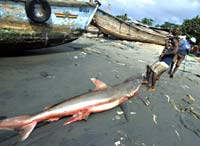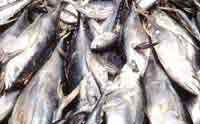|
Rome -- Experts convened by the UN Food and Agriculture Organization (FAO) and the World Health Organization (WHO) today announced agreement on recommendations regarding safe intake levels for a variety of different chemicals occurring in food, including cadmium and methylmercury, the most toxic form of mercury.
Forty-eight scientists from 17 countries participated in the 61st meeting of the Joint Expert Committee for Food Additives and Contaminants (JECFA) from 10-19 June at FAO's Rome headquarters. Established by FAO and WHO in 1956, JECFA meets regularly to provide safety and risk assessment advice to countries and to the Codex Alimentarius Commission. Codex recommends international standards for food safety and quality, as well as codes of practice and guidelines.
In the light of new data, the experts re-evaluated previous JECFA risk assessments for cadmium and methylmercury, which are largely unavoidable food contaminants. In the case of cadmium, the Committee concluded that the new data did not provide a sufficient basis for changing the currently recommended Provisional Tolerable Weekly Intake (PTWI) of cadmium of 7 micrograms per kilogram of body weight (µg/kg). While stressing that kidney disease is a serious health concern associated with excessive cadmium intake, the advisory body concluded that consumption at or below the currently established PTWI would not increase the risk of kidney problems.
Fish play a key role in meeting nutritional needs in many countries.
On methylmercury the Committee received and reviewed
additional information that had been requested previously.
Based on this, the experts revised the PTWI for
methylmercury, recommending that it be reduced to
1.6 µg per kg body weight per week in order to sufficiently
protect the developing foetus. The foetus is exposed to
methylmercury through contaminated food eaten by the
pregnant mother.
This new recommendation changes the prior recommendation for a dietary limit of 3.3 µg per kg body weight per week.
The Committee noted that some fish species (e.g. swordfish and sharks) are the most significant source of methylmercury in food. The experts stressed that when providing advice to consumers and setting limits for methylmercury concentrations, public health authorities should keep in mind that fish play a key role in meeting nutritional needs in many countries.
A summary of the expert report is available online.
Contact:
George Kourous
Information Officer, FAO
(+39) 06 57053168
george.kourous@fao.org
Or
Gregory Hartl
Communications Adviser for Sustainable Development and Healthy Environments
WHO, Geneva
Tel: (+41) 22 791 4458
Mobile: (+41) 79 203 6715
hartlg@who.int
Top
|

